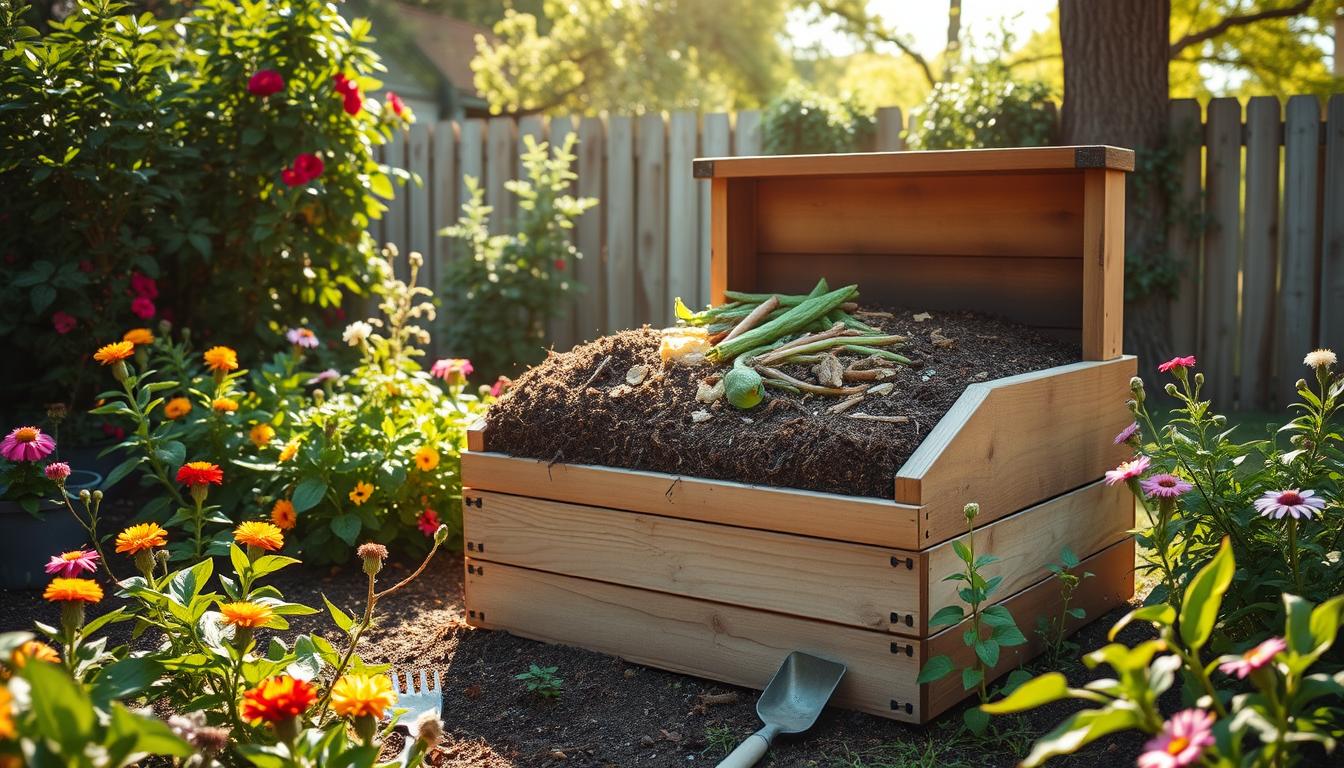I’m excited to share the basics of composting for beginners. It’s a simple way to reduce waste and make nutrient-rich soil for your garden. Learning composting basics is easy, and you can start composting at home with just a few steps. We’ll cover the basics, including what materials to compost and how to keep your pile healthy.
For beginners, knowing composting’s benefits is key. It’s a great start to sustainable gardening. With the right knowledge, you can make your garden thrive using easy composting methods. This guide is for everyone, whether you’re new to gardening or have experience.
What is Composting and Why Should I Care?
Exploring composting for beginners, I’ve found it’s a big win for my garden and the planet. It’s the natural breakdown of organic stuff like food scraps and yard waste into a soil booster. This happens when tiny life forms like bacteria and fungi eat the waste, making heat, carbon dioxide, and water vapor.
Starting a compost pile helps me cut down on waste, makes a natural fertilizer, and boosts plant health. Simple steps can lead to big changes. For example, composting makes soil better for plants, improving its health and structure.
Understanding Composting Basics
To start composting, knowing the basics is key. This means figuring out what to compost, keeping it moist, and solving common problems. Some perks of composting include:
- Less waste
- A natural fertilizer
- Better soil health
- Healthier plants
Benefits for My Garden and the Environment
Composting is great for my garden and the environment. It’s a green way to handle waste. This approach can lower harmful emissions, save water, and support more life.
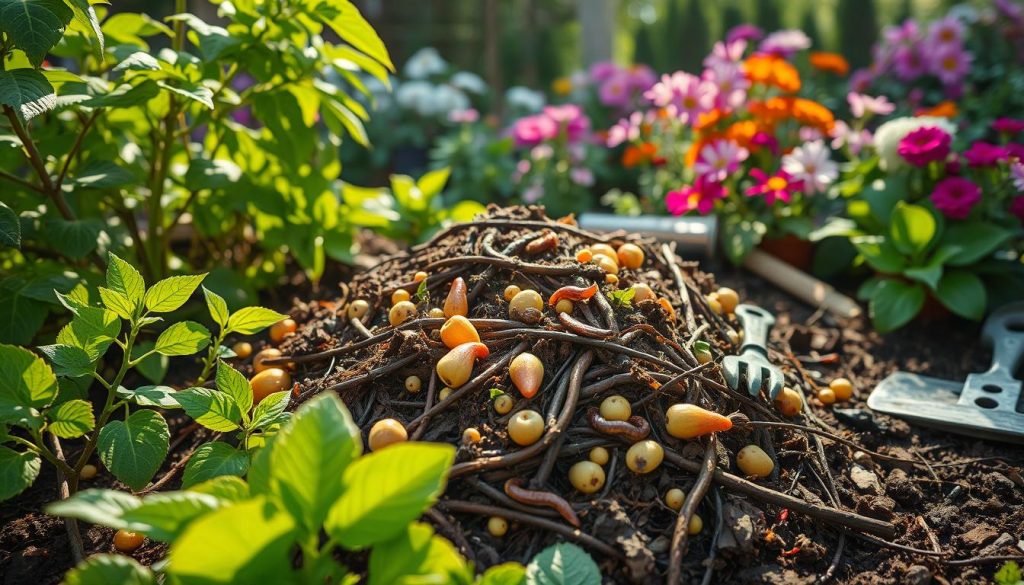
Getting Started with Composting
To start composting, you need to know the basics. As a beginner, pick a composting method that fits your life. A beginner’s guide can help you set up your composting system and turn waste into soil.
One key thing in composting is the carbon-to-nitrogen ratio. This balance helps microorganisms break down waste. Simple tips can keep your compost pile healthy and productive.
Choosing the Right Composting Method
There are many composting methods, like bin composting, pile composting, and vermicomposting. Each has its pros and cons. The best choice depends on your space, budget, and preferences. Here are some options:
- Bin composting: Use a compost bin for small spaces. You can buy one or make your own.
- Pile composting: Make a compost pile in your yard. It’s cheap but needs space and care.
- Vermicomposting: Use worms to compost indoors. It’s fun and educational.
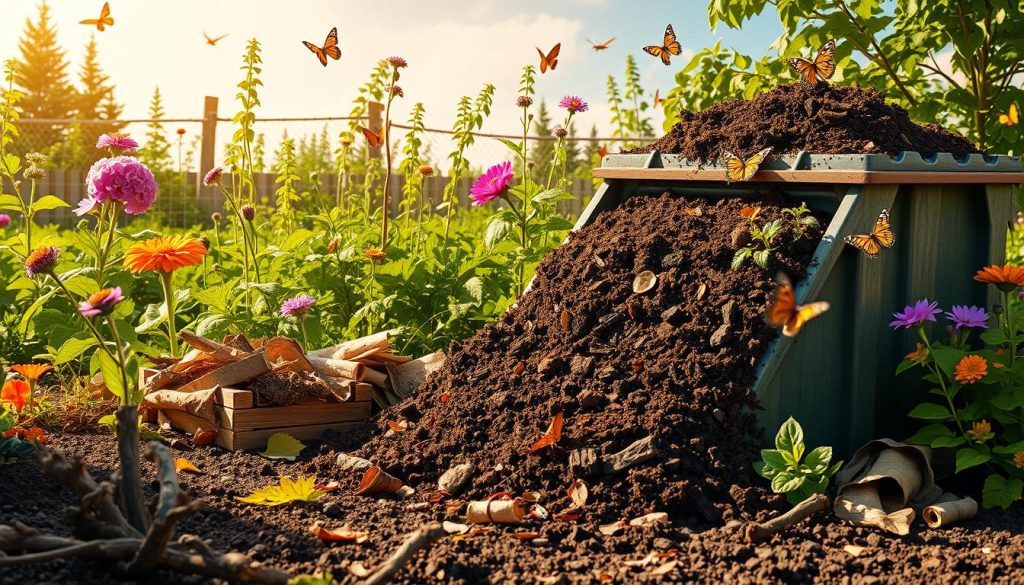
Essential Tools for Beginner Composters
After picking your method, get the right tools. You’ll need a compost bin, a pitchfork, and a watering can. With the right tools and a beginner’s guide, composting can be fun and rewarding.
What Can I Compost?
Starting with composting for beginners, I often wonder what can be composted. The answer is simple. Most organic materials can be composted, like kitchen scraps and yard waste. It’s all about knowing what can be composted and how to do it at home.
Kitchen scraps are a great starting point for easy composting at home. These include fruit and vegetable peels, tea bags, and coffee grounds. They are full of nutrients and can be added to the compost pile. Here are some kitchen scraps you can compost:
- Fruit and vegetable peels
- Tea bags
- Coffee grounds
- Eggshells
- Bread and grains
Yard waste, like leaves and grass clippings, can also be composted. It’s a natural way to manage yard waste. By following these basics, I can make a nutrient-rich soil amendment for my garden.
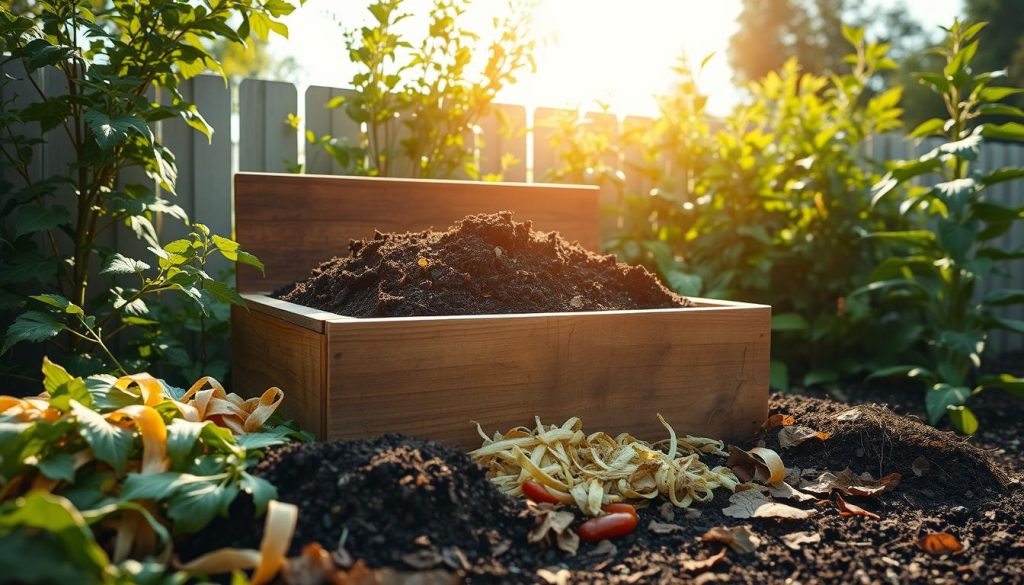
Composting is a simple way to reduce waste and make a sustainable garden. Knowing what can be composted and how to do it at home is easy. Anyone can start composting and enjoy its benefits.
What Should I Avoid Composting?
Starting to compost? It’s key to know what not to add to your pile. A good beginner guide will help you make a balanced compost. Not all organic stuff is good for composting.
Some items can bring pests, bad smells, or mess up your compost. Meat, dairy, and oils are bad for composting. Also, avoid pet waste, weeds with seeds, and anything diseased or moldy. They can harm your compost.
Common Materials to Avoid
- Meat, dairy, and oily foods
- Pet waste
- Weeds with seeds
- Diseased or moldy materials
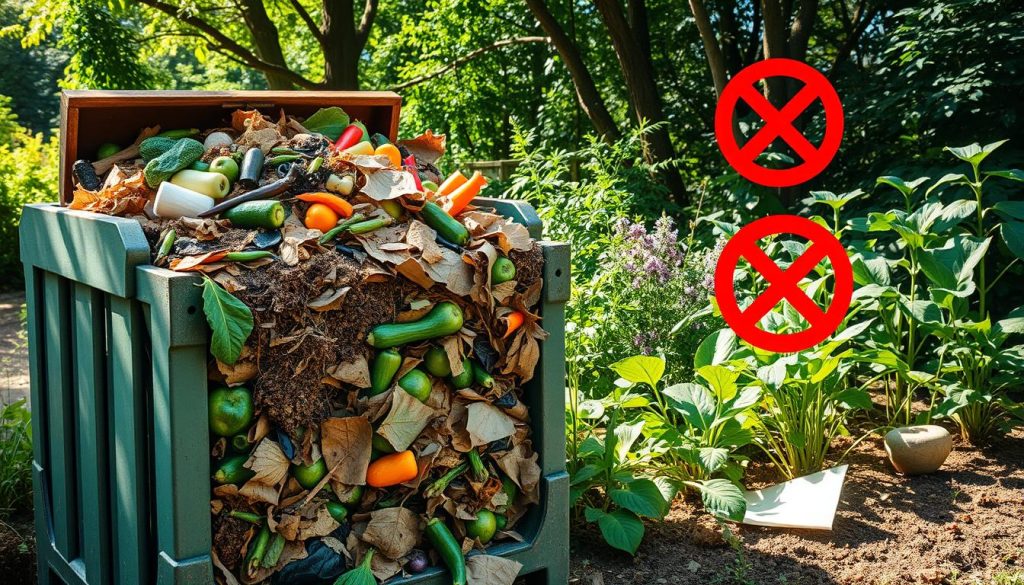
Toxic Waste Management
Knowing what not to compost is crucial for a healthy pile. By following these tips, you’ll get a compost that’s good for your garden and the planet. Always check local guidelines for toxic waste disposal.
How to Build Your Compost Pile
Starting a compost pile can seem hard at first, but it’s easy once you know the basics. First, pick a spot for your compost bin. It should be in a place with good air and close to water.
Layering Materials for Success
To make your compost pile, layer your materials. Start with 4-6 inches of brown stuff like leaves or straw. Then, add a layer of green stuff like kitchen scraps or grass clippings. Here’s how to layer:
- Start with a 4-6 inch layer of brown materials
- Add a layer of green materials, such as kitchen scraps or grass clippings
- Repeat the layers, ending with a layer of brown materials
Maintaining the Right Moisture Levels
Keeping the right moisture is key for a healthy compost pile. It should be moist but not too wet. Here’s a table to help you get it right:
| Moisture Level | Description |
|---|---|
| Too Dry | The compost pile is dry and crumbly |
| Just Right | The compost pile is moist, but not waterlogged |
| Too Wet | The compost pile is waterlogged and soggy |
The Science Behind Composting
Composting is a complex process. It involves breaking down organic materials by microorganisms like bacteria and fungi. These microorganisms feed on the organic matter, releasing heat, carbon dioxide, and water vapor. This is key for composting at home.
For beginners, composting can seem daunting. But understanding how microorganisms break down materials makes it easier. The ideal composting temperature is between 130°F and 140°F. This temperature is hot enough to kill pathogens but not too hot for beneficial microorganisms.
How Microorganisms Break Down Materials
Microorganisms are the heart of composting. Their activity depends on temperature, moisture, and oxygen levels. For beginners, it’s crucial to balance these factors to create a good environment for microorganisms. By following basic composting steps, you can easily compost at home and get nutrient-rich soil.
The Role of Temperature in Composting
Temperature is key in composting. It affects how fast microorganisms work. The ideal temperature range is between 130°F and 140°F. This range is perfect for breaking down organic matter efficiently.
| Temperature Range | Microbial Activity |
|---|---|
| 130°F – 140°F | Optimal microbial activity |
| 140°F – 150°F | Reduced microbial activity |
| Above 150°F | Microbial activity ceases |
By understanding composting’s science and following basic steps, you can create a thriving compost pile. This pile will give you nutrient-rich soil for your garden. Whether you’re new to composting or experienced, composting at home is achievable with the right knowledge and techniques.
Troubleshooting Common Composting Issues
Starting to compost can be a learning curve. Issues like smelly compost or a pile that’s too wet or dry can be a challenge. But, there are easy fixes. Follow these tips to avoid these problems and make a healthy compost pile.
At first, I had smelly compost. I found out it was because of too many green materials. To fix it, I added more brown materials like leaves or straw. If your compost smells, try adding more brown materials to balance it out.
Smelly Compost: Causes and Solutions
- Too many green materials: add more brown materials like leaves or straw
- Not enough oxygen: turn the pile to aerate it
- Too much moisture: add more brown materials or turn the pile to dry it out
Compost that’s too Wet or Dry
It’s key to keep an eye on moisture levels in your compost. If it’s too wet, add brown materials to soak up the excess. If it’s too dry, add green materials or water to moisten it. These tips will help you maintain a healthy compost pile.
Composting needs patience and careful attention. By tackling common issues and following these tips, you’ll make a compost that’s good for your garden and the planet. Happy composting!
| Composting Issue | Cause | Solution |
|---|---|---|
| Smelly Compost | Too many green materials | Add more brown materials |
| Compost too Wet | Too much moisture | Add more brown materials or turn the pile |
| Compost too Dry | Not enough moisture | Add more green materials or water |
Understanding Different Composting Methods
Starting to compost can be exciting, especially for beginners. There are several methods to choose from, like bin composting, pile composting, or vermicomposting. Each has its own benefits and drawbacks, depending on what you need and like.
Simple composting techniques work with all these methods. For instance, bin composting uses a bin to hold the materials. Pile composting doesn’t use a bin but still works well. Vermicomposting, or worm composting, uses worms to break down the materials.
Comparing Composting Methods
- Bin composting: ideal for small spaces and easy to maintain
- Pile composting: suitable for larger spaces and can be more cost-effective
- Vermicomposting: perfect for indoor composting and can be a fun and educational experience
Choosing the right composting method and using simple techniques can help you create a great compost pile. This pile will give your garden the nutrients it needs. Whether you’re new to composting or have experience, knowing the different methods can help you succeed and help the environment.
| Composting Method | Advantages | Disadvantages |
|---|---|---|
| Bin Composting | Easy to maintain, ideal for small spaces | Can be expensive, limited capacity |
| Pile Composting | Cost-effective, suitable for large spaces | Requires more maintenance, can be unsightly |
| Vermicomposting | Perfect for indoor composting, educational experience | Requires special equipment, can be slow |
Knowing When My Compost is Ready
Learning about composting basics is key for easy composting at home. It’s not hard for beginners with the right tips. To know if my compost is ready, I check its temperature and texture.
A mature compost pile smells earthy and has no big pieces left. It should be between 50°F and 70°F. I use a thermometer and my hand in gloves to check. If it’s crumbly, it’s ready for my garden.
Signs of Mature Compost
- Dark color
- Earthy aroma
- Crumbly texture
- Free of recognizable pieces of original materials
By following these steps, I make sure my compost is ready. It’s great for my plants and good for the environment. Composting at home is easy and helps my garden grow well.
| Compost Characteristic | Description |
|---|---|
| Temperature | Between 50°F and 70°F |
| Texture | Crumbly and easy to handle |
| Aroma | Earthy and pleasant |
How to Use Finished Compost Effectively
As a beginner composter, it’s key to know how to use finished compost well. This way, you can make the most of your composting. Finished compost helps improve soil health and structure. It’s great for garden beds, containers, and pots, making plants grow better.
Using compost right is important. Here are some tips for beginners:
- Mix compost into the soil to a depth of 8-10 inches
- Use the right amount of compost, about 2-4 inches per bed
- Avoid over-fertilization by not exceeding the recommended amount
By following these steps, you can cut down on synthetic fertilizers. This makes your gardening more sustainable. If you’re new to composting, learning the basics is crucial. It helps your garden and the environment.
For more composting info, check out online resources. They offer detailed tips and advice. With practice and patience, you’ll become a skilled composter. Enjoy the many benefits of composting.
Continuous Composting: What’s Next?
Congratulations on starting your composting journey! Remember, composting is a continuous process. It needs your ongoing attention and care. Keep adding fresh materials, turning the pile, and checking moisture levels.
As you get more experience, try advanced techniques like vermicomposting or bokashi composting. These can improve your compost’s quality and quantity.
Maintaining a Compost Routine
Make composting a regular part of your routine. I’ll keep adding kitchen scraps, yard trimmings, and other approved materials. This ensures a balanced mix.
Regularly turning the materials helps aerate the pile. It also speeds up decomposition.
Exploring Advanced Composting Techniques
Once I’m comfortable with the basics, I’ll try more advanced methods. Techniques like vermicomposting or bokashi composting can produce better compost. They also help manage waste and reduce odors.

